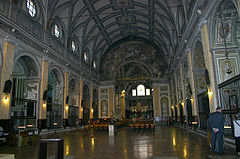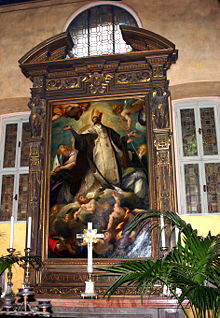
Sant'Angelo (Milan)
Encyclopedia


Milan
Milan is the second-largest city in Italy and the capital city of the region of Lombardy and of the province of Milan. The city proper has a population of about 1.3 million, while its urban area, roughly coinciding with its administrative province and the bordering Province of Monza and Brianza ,...
, Lombardy
Lombardy
Lombardy is one of the 20 regions of Italy. The capital is Milan. One-sixth of Italy's population lives in Lombardy and about one fifth of Italy's GDP is produced in this region, making it the most populous and richest region in the country and one of the richest in the whole of Europe...
, northern Italy
Italy
Italy , officially the Italian Republic languages]] under the European Charter for Regional or Minority Languages. In each of these, Italy's official name is as follows:;;;;;;;;), is a unitary parliamentary republic in South-Central Europe. To the north it borders France, Switzerland, Austria and...
, belonging to the Franciscan
Franciscan
Most Franciscans are members of Roman Catholic religious orders founded by Saint Francis of Assisi. Besides Roman Catholic communities, there are also Old Catholic, Anglican, Lutheran, ecumenical and Non-denominational Franciscan communities....
Order.
The church was constructed in the mid-16th century by the Spanish general and Governor Milan Ferrante Gonzaga
Ferrante Gonzaga
Ferrante I Gonzaga was an Italian condottiero, a member of the House of Gonzaga and the founder of the branch of the Gonzaga of Guastalla.-Biography:...
, over an edifice already existing in 1418, in replacement of the eponymous one, which had been destroyed to build the new walls. The design was by Domenico Giunti. The small bell tower is from 1607, while the façade was finished only in 1630, in late-Mannerist style. The church is one of the few in the city which has not been restored in "neo-medieval" style during the 19th century.
It has a single nave with side chapels and barrel vault
Barrel vault
A barrel vault, also known as a tunnel vault or a wagon vault, is an architectural element formed by the extrusion of a single curve along a given distance. The curves are typically circular in shape, lending a semi-cylindrical appearance to the total design...
, a transept
Transept
For the periodical go to The Transept.A transept is a transverse section, of any building, which lies across the main body of the building. In Christian churches, a transept is an area set crosswise to the nave in a cruciform building in Romanesque and Gothic Christian church architecture...
and a deep presbytery
Presbytery (architecture)
The presbytery is the name for an area in a church building which is reserved for the clergy.In the oldest church it is separated by short walls, by small columns and pilasters in the Renaissance ones; it can also be raised, being reachable by a few steps, usually with railings....
. Artworks include works by Gaudenzio Ferrari
Gaudenzio Ferrari
Gaudenzio Ferrari was a Northern Italian painter and sculptor of the Renaissance.-Biography:Gaudenzio was born at Valduggia in the Valsesia in the Duchy of Milan. Valduggia is now in the Province of Vercelli in Piedmont. He is said to have first learned the art of painting at Vercelli from...
(chapel of St. Catherine, now replaced by a copy; the original is in the Pinacoteca di Brera), Antonio Campi
Antonio Campi
Antonio Campi was an Italian painter of the Renaissance.He was born in Cremona. His style merges Lombard with Mannerist styles. In Cremona, his extended family were the main artistic produce. Giulio Campi and Antonio were reportedly half-brothers, while Vincenzo Campi was a full brother....
(same chapel), Morazzone
Pier Francesco Mazzucchelli
Pier Francesco Mazzucchelli was an Italian painter of the early Baroque era in Milan....
(St. Charles Borromeo
Charles Borromeo
Charles Borromeo was the cardinal archbishop of the Catholic Archdiocese of Milan from 1564 to 1584. He was a leading figure during the Counter-Reformation and was responsible for significant reforms in the Catholic Church, including the founding of seminaries for the education of priests...
in Glory), Simone Peterzano
Simone Peterzano
Simone Peterzano was an Italian painter of the later Mannerism, native of Bergamo. He is mostly known as the master of Caravaggio....
(frescoes in the St. Anthony Chapel), Ottavio Semino (Brasca Chapel in the transept), Camillo Procaccini
Camillo Procaccini
thumb|300px|Nativity by Camillo ProcacciniCamillo Procaccini was an Italian painter. He has been posthumously referred to as the Vasari of Lombardy, for his prolific Mannerist fresco decoration....
(frescoes in the transept and in several chapels) and Giulio Cesare Procaccini
Giulio Cesare Procaccini
Giulio Cesare Procaccini was an Italian painter and sculptor of the early Baroque era in Milan.-Biography:Born in Bologna he was son of the Mannerist painter Ercole Procaccini the Elder and brother of Camillo Procaccini and Carlo Antonio Procaccini...
(Nativity, in the rococo
Rococo
Rococo , also referred to as "Late Baroque", is an 18th-century style which developed as Baroque artists gave up their symmetry and became increasingly ornate, florid, and playful...
sacristy).
The triumphal arch has a frescoes with a solemn Incoronation of Mary by Stefano Maria Legnani
Stefano Maria Legnani
Stefano Maria Legnani , also known as "Legnanino", was an Italian painter of the Baroque period, active mainly in Milan. He was a pupil of his father, the painter Ambrogio Legnani. He then went on to work in the studio of Carlo Cignani in Bologna, and Carlo Maratta in Rome. In Novara, he painted...
(Legnanino).
The convent is a 20th century addition.

